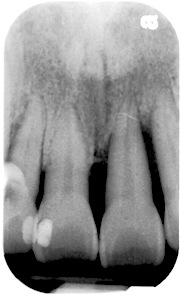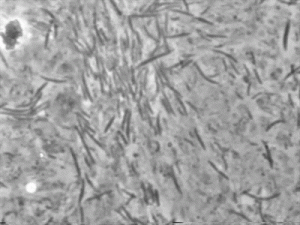Periodontal Disease – Gum Disease
1. What is it?
Gum conditions are quite prevalent, although most people affected have the milder, non-destructive irritations of gingivitis. Gums can be red, swollen, and bleed easily, but without structural damage. Gingivitis clears up readily with routine in-office cleaning and good home hygiene habits.
What we’re really concerned with is the less frequent, but more serious periodontitis, which features damage to the structures that hold teeth in the jawbone.

Consider the teeth in this x-ray. The tooth on the left is wrapped with jawbone, holding it firmly in place.
The tooth on the right only has bone holding the tip of the root. The missing bone tissue was destroyed by the action of periodontal disease.
This condition often develops completely without symptoms, but eventually the tooth becomes loose, drifts out of position, and ultimately falls out. Sometimes in the late stages, an overt infection sets in, with pain and swelling.
This disease process causes the majority of tooth loss in adults. Its signs usually emerge in early middle age, though sometimes in younger individuals. It is one of the main things we look for in every dental examination, and if it’s present we always hope to find it in the earliest stages.
2. What causes it?

Periodontal disease is caused by uncontrolled masses of bacteria.
Periodontal disease is caused by an unfortunate combination of specific, particularly irritating bacteria, and the body’s reaction to them. The destruction it causes is, very literally, collateral damage in the war between the germs and the white blood cells.
Of the hundreds of bacterial species that occur in the human mouth, only a few are considered to be the main pathogens of gum disease. They are not rare, but not everyone harbors them. Likewise, it takes a strong, even an exaggerated, immune response to those pathogens to create the conditions for destructive periodontal disease.
3. How do we detect it?
The most frequent, reliable method is the basic clinical exam and x-rays, in which we probe the gums for any early signs of damage. We look for “pockets” in the gums, probing around each tooth, and evidence of bone loss on the x-rays.
There are other diagnostic techniques that may be used as an assessment of risk. Both the pathogenic bacteria and the level of immune response can be tested for. An older, often helpful method is to examine the bacteria from the gums under a microscope.
4. What can we do about it?
Treatment options for periodontal disease range from the toothbrush to surgery. In our biologically oriented practice, we try to create conditions that arrest the disease process. It boils down to two strategies:
- Reduce the bacterial load, by cleaning teeth and killing the germs;
- Making sure the body is well enough nourished to support the continual healing that must take place in the gum tissues.
5. Cleaning teeth and killing germs:
People who have real gum disease cannot afford to be casual about cleaning their teeth. Control of the disease requires thorough professional cleaning to start, attention to home care every day, and professional cleaning three or four times a year. It’s a matter of perpetual maintenance, because the germs will always grow back.
We will coach our patients on the best methods to use at home to keep the teeth clean.
6. Nutrition in periodontal disease:
Breakdown of periodontal tissues indicates that the destructive process has overcome the body’s ability to resist and heal. Resistance and healing depend on the cells having the resources to repair and regenerate. That means nutrition!
A good diet, plenty of vitamins, minerals, protein, essential fats, etc., a minimum of processed foods and sugars – it’s all good advice. It’s worth the trouble to consult with a nutrition professional to identify elements you may be deficient in, to identify foods you don’t tolerate, and to be sure your diet is most appropriate for you.
Beyond good basics, there are a few specific nutrients that are most commonly deficient in gum disease, and should be supplemented.
